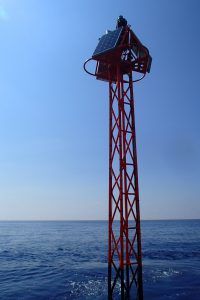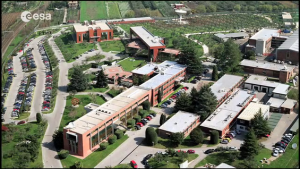
Under water view of the four BOUSSOLE instrumented arms. Courtesy of CNRS/LOV.
European Space Agency
organized an international workshop
Options for future European satellite OCR vicarious adjustment infrastructure for the Sentinel-3 OLCI and Sentinel-2 MSI series
on 21 – 23 February 2017 ESA/ESRIN, Frascati, Italy
Gallery I Presentations you will find under Agenda
D-240 Proceedings of WKP-1 (PROC-1) Report of the international workshop
Workshop will be held from 21 – 23 February 2017 in Magellan room in ESRIN.
DAY 1 – Tue, 21 February 2017
DAY 2 – Wed, 22 February 2017
DAY 3 – Thu, 23 February 2017
Time |
Session |
9:00 |
Session 10 – Conclusions/ Wrap up (chair R. Santoreli) |
| EEA’s coordination role vis-à-vis the Copernicus in Situ Component. Henrik Steen Andersen (pdf) | |
| Summary of key findings from session chairs | |
| Discussion (C. Donlon) | |
10:45 |
Break |
11:05 |
Round tables (Chair C. Donlon) |
|
|
12:05 |
Conclusion of the workshop |
12:30 |
End of the day |
The ocean colour community has been granted access to continuous ocean colour data since the late 90s with the successful launch and operation of SeaWiFS, MODIS, MERIS and VIIRS. Ocean Colour Radiometry (OCR) is now entering a new era with the COPERNICUS space component and the Sentinel-3 programs. The Sentinel series will indeed ensure continuous data flow from identical sensors, therefore opening the path to operational services. A fundamental interest of the ocean colour sensors for the scientific community is to provide worldwide information that can be analysed and interpreted in a context of global climate change. This unique data source is therefore a key element to construct Climate Data Records (CDRs) of Essential Climate Variables (ECVs).

Emerging part of BOUSSOLE buoy in the Mediterrean Sea. Courtesy of Laboratoire Oceanographique de Villefranche (CNRS/LOV).
The historical uncertainty requirement for remotely-sensed water leaving reflectance (ρw) was defined as 5% in the blue green part of the spectrum (Gordon & Clark, 1981, Gordon et al., 1983, Gordon, 1987, Gordon 1997).
However, it has been demonstrated (Gordon, 1998, Hooker et al 1992, Hooker and McClain 2000) that reaching a 5% accuracy on requires an absolute accuracy on between 0.25% and 1%, which cannot be insured through purely instrumental calibration and characterisation. For this reason, we rely on vicarious adjustment, that is on a complementary calibration using ground-truth measurements (Franz et al. 2001, Franz et al. 2007; Bailey et al. 2008), to meet the 5% requirement accuracy.
Historical methods to derive operational vicarious adjustment gains have been derived from a two steps procedure:
- Gain computation over NIR bands of the spectrum.
- Gain computation over visible bands of the spectrum.
The first one, just like the basis for atmospheric correction relies on the black pixel assumption that is the sea water is black in the NIR infrared bands. For this first step, we can make use of the clearest regions of the world ocean like the South Pacific Gyre. This step does not rely on actual in situ measurements and we can therefore rely on statistically representative computation of NIR gains.
The latest rely on the availability of highly accurate and precise in situ reference measurements preferably collected in clear oligo or mesotrophic water. Owing to the necessity to produce statistically reliable gains and over a sufficiently long period of time, the fundamental sources of such data are coming from long term deployment of radiometric buoys, namely BOUSSOLE and MOBY.
With the perspective of the Sentinel-2 and Sentinel-3 series of COPERNICUS space program and the objectives in operational oceanography, it appears necessary to rethink and secure a permanent flow of FRM for orbital sensors vicarious adjustment.
The objective of this workshop is to gather experts in the different fields involved in vicarious adjustment and open a wide range debate on the best way to go for future long term vicarious infrastructure.
Copernicus program represent a major evolution with Ocean Colour Radiometry (OCR) going operational with the S3 OLCI series therefore providing the guaranty of a continuous flow of consistent products for the next decades. OCR relies on vicarious adjustment to ensure the expected accuracy on geophysical products. To ensure the best possible product delivery to users, ESA is organizing an international workshop from the 21 – 23 February, 2017 to evaluate the options for future European satellite OCR vicarious adjustment infrastructure for the Sentinel-3 OLCI and Sentinel-2 MSI series.
The workshop will include a review of historical and contemporary approaches, review lessons learnt from international teams, analyses of strengths and weakness of alternative methods and approaches. An important aspect of the workshop will be to review and define justified and traceable requirements for vicarious adjustment measurements, the so called Fiducial Reference Measurements (FRM) to be made in support of satellite OCR vicarious adjustment. An expected outcome of the workshop will be to derive an optimum location and concept for a future European OCR vicarious adjustment infrastructure.
Participation registration deadline was 15 Nov 2016.
 Venue
Venue
The FRM4SOC Workshop on Vicarious Infrastructure will take place in ESA/ESRIN, Frascati, Italy.
How to get to ESRIN?
Information how to get to ESRIN you will find here.
Accommodation
Organizers suggest following hotels in Frascati:
- Hotel Colonna (http://www.hotelcolonna.it/en/)
- Hotel Flora (http://www.hotel-flora.it/)
- Hotel Bellavista Frascati (http://www.hbellavista.it)
- Villa Mercede (http://www.villamercede.com/)
- Hotel Cacciani (http://www.cacciani.it)
Average room rate is between 90 and 120 Euros. Some of them will give special price if you fill out the Hotel Form and follow the intructions on the form.
For further information please contact
Christophe Lerebourg
E-mail: Christophe.Lerebourg@acri-st.fr
or
Craig Donlon
E-mail: Craig.Donlon@esa.int
